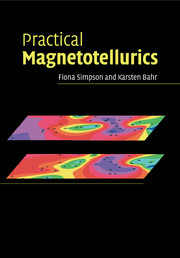Book contents
- Frontmatter
- Contents
- Preface
- Symbols
- 1 Introduction
- 2 Basic theoretical concepts
- 3 Planning a field campaign
- 4 From time series to transfer functions: data processing
- 5 Dimensionality and distortion
- 6 Numerical forward modelling
- 7 Inversion of MT data
- 8 The general link to other geosciences: conduction mechanisms
- 9 The special link to other geosciences
- 10 Other EM induction techniques
- Appendix 1 Theorems from vector calculus
- Appendix 2 The transfer function in the wavenumber-frequency domain and equivalence transfer functions
- Appendix 3 Probability distributions
- Appendix 4 Linear regression
- Appendix 5 Fourier analysis
- Appendix 6 Power and cross spectra
- Glossary
- References
- Index
3 - Planning a field campaign
Published online by Cambridge University Press: 03 December 2009
- Frontmatter
- Contents
- Preface
- Symbols
- 1 Introduction
- 2 Basic theoretical concepts
- 3 Planning a field campaign
- 4 From time series to transfer functions: data processing
- 5 Dimensionality and distortion
- 6 Numerical forward modelling
- 7 Inversion of MT data
- 8 The general link to other geosciences: conduction mechanisms
- 9 The special link to other geosciences
- 10 Other EM induction techniques
- Appendix 1 Theorems from vector calculus
- Appendix 2 The transfer function in the wavenumber-frequency domain and equivalence transfer functions
- Appendix 3 Probability distributions
- Appendix 4 Linear regression
- Appendix 5 Fourier analysis
- Appendix 6 Power and cross spectra
- Glossary
- References
- Index
Summary
The choice of equipment used in a particular survey should depend on the depth range under consideration: in crustal studies, induction coil magnetometers are used frequently, the sampling is quick and the ‘processing’ (described in Chapter 4) is usually performed in the field. Fluxgate magnetometers provide a response at longer periods than induction coils, and are used if larger penetration depths are under consideration. In many cases, data from very short to very long periods are desirable, and two different sensors are combined at each site. It is vital that anybody writing or modifying processing software has access to all information regarding the analogue electronics of the system (e.g., calibration coefficients for filters) that is to be used in conjunction with the software.
We suggest a rule of site spacing: not too close and not too sparse. The question whether we should deploy magnetotelluric sites along a profile, or as a 2-D array is discussed in the context of the geological complexity of the target area, the available hardware and the financial resources. In many cases, a trade-off has to be found between the desire to have many sites and hence a good spatial resolution and the wish to achieve high-quality data by occupying sites for a long time.
Target depths and choosing the right sensors and equipment
Considering the period range
From the definition of penetration depth (Equation (2.20)), we can estimate a period range associated with a particular depth range of interest, provided that an estimate of the subterranean conductivity is known.
- Type
- Chapter
- Information
- Practical Magnetotellurics , pp. 37 - 57Publisher: Cambridge University PressPrint publication year: 2005
- 1
- Cited by



